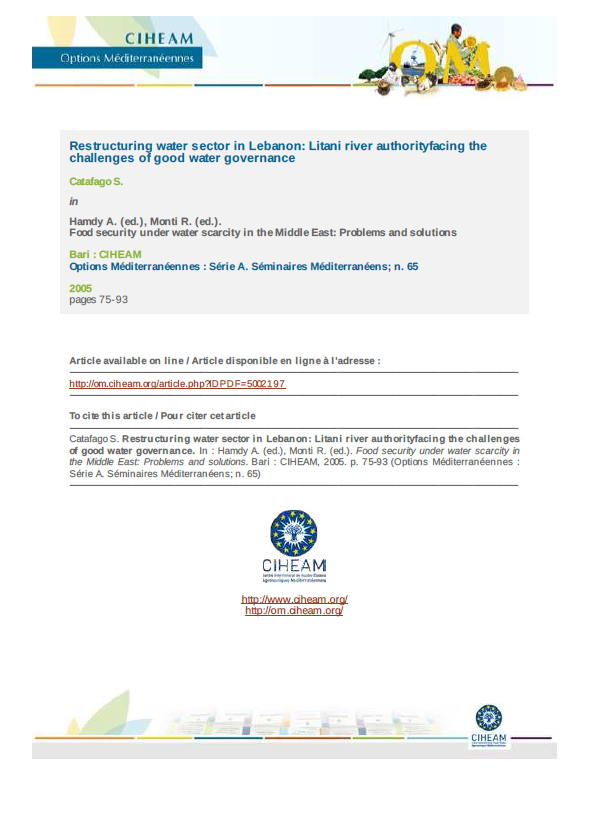Restructuring water sector in Lebanon: Litani river authority facing the challenges of good water governance
 |
article Jan 2005 ; 20 pages
Aut. Selim Catafago
Ed. CIHEAM - Paris
Téléchargeable sous format: PdF
Téléchargeable chez l'éditeur
Abstract:
The new organization of the water sector in Lebanon is governed by three laws: Law
221 issued on May 29th 2000, corrected by the Law 241 issued on August 7th 2000, and amended by
Law 377 issued on December 14th 2001. Lately, Decree No 8122, dated on July 3rd 2002, has defined
some application processes of Law 221, particularly relating to the merging of water bodies. The spirit
of this law is to separate clearly between the macro and micro management of water, and to
strengthen the policy of the decentralization by granting more autonomy to regional authorities
involved by day to day management of the water supply. This Law encourages implicitly the regional
water authorities to manage their establishment on commercial basis and to be ready to deal in the
future with the private sector. The nature and the level of private public partnership could be defined
accordingly to the needs, to the improvement of requested services and by taking into account the
socio-economic situation. The Law 228 issued on May 31st 2000 aimed to support the restructuring of
the water sector by regulating privatization activities and defining their conditions and applications.
The Litani River Authority (LRA) is partially involved in this reform. It is still functioning according to its
creation Law issued on August 14th 1954. Its mission has been extended recently to the Hasbani
watershed. Beside the main hydroelectricity and irrigation missions, the competencies covered by
LRA are: the agricultural research, the rural development, studies and construction of dams and
irrigation projects, the management of hydrometric gauge stations on all the Lebanese rivers, the
monitoring and the prevention of pollution. Water policy and allocation, different programs, and their
implementation take into account the highest social benefits compatible with the most economical
investment and expenses. It is a permanent challenge to fit these objectives: procure a good welfare
and an acceptable level of water and food securities to the people.
Contents:
1. HISTORICAL
1.1. At the time of the Ottoman Empire
1.2. At the time of the French Mandate
1.3. Post independence period
1.4. Situation until year 2000 – institutions and management
1.4.1. Ministry of hydraulic and electric resources
1.4.2. Water authorities
1.4.3. Actors dealing with water
2. REORGANIZATION AND RESTRUCTURING OF WATER SECTOR
2.1. Lebanon facing to satisfy needs in space and time
2.2. Some deficiencies in the administrative and financial operating systems
2.3. Initiation of the reform
2.3.1. For the World Bank
2.3.2. Lebanese government policy
2.3.3. Head lines of the reform
2.3.4. Actions undertaken by the Lebanese government
3. LITANI RIVER AUTHORITY
3.1. Litani river
3.2. Creation law and objectives
3.3. Administrative organization
3.4. Main projects
3.4.1. Actual activities
3.4.2. Master Plan, first phase
3.4.3. Examples of optimization approach
4. CONCLUSION
Public-Cible:
Mots clefs: |
gestion de la ressource en eau (CI) (DT) (OP) (ope) , législation, lois (CI) (DT) (OP) (ope) |
Pays concerné: |
Editeur/Diffuseur: |
|
CIHEAM
-
Centre International de Hautes Etudes Agronomiques Méditerranéennes - Paris |
En cas de lien brisé, nous le mentionner à communication@pseau.org